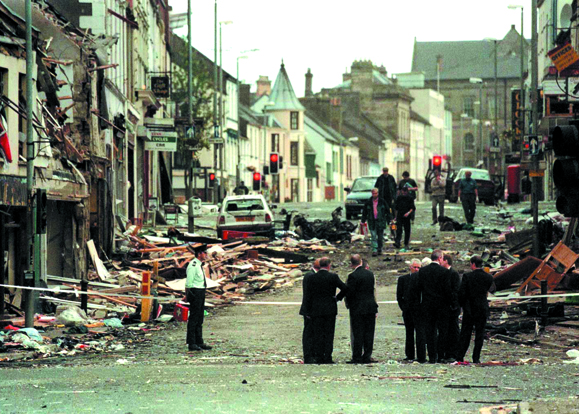A report on the Omagh atrocity has heavily criticized the controversial Special Branch of the Northern Irish police force for allegedly failing to act on an informer’s warning that dissident republicans intended to launch an attack in the County Tyrone town. A wave of disgust greeted the news that the warning had been received 11 days before the massive Real IRA bomb ripped the heart out of the town, killing 29 people, including one woman who was eight months pregnant with twins, on August 15, 1998.
Senior Ulster Unionists have attacked the report’s author, Police Ombudsman (Police Complaints Commissioner) Nuala O’Loan, rather than criticize senior Special Branch members who appeared to have ignored the warning. Mrs. O’Loan refused a request by Chief Constable Ronnie Flanagan for a delay in publication to allow a point-by-point reply to be formulated.
Flanagan said the report “contained so many significant factual inaccuracies, unwarranted assumptions, misunderstanding and material omissions” that a request has been made to the Ombudsman’s office for a reasonable period of time “to respond in detail with what we see as the serious deficiencies in this report.”
Mrs. O’Loan and her investigators began her probe into the police intelligence files on the attack, after newspapers printed an informer’s claim that he had tipped off police about a planned dissident republican bomb attack. The informer did not specify Omagh, but while investigating the claim, the Ombudsman’s team discovered evidence of another, more detailed warning. The second tip-off, made on August 4, 1998 to an Omagh detective constable, lasted more than 10 minutes and revealed that an attack would take place in the town on August 15. The detective constable, who is said in O’Loan’s report to have acted responsibly at all times, passed the information to his superior who then briefed the Special Branch. The highly secretive group, which operates closely with British intelligence agencies, is said not only to have refused to act on the tip-off but also to have failed to link the information about an imminent bombing with the warning of an attack on Omagh. O’Loan’s report stopped short of saying that the attack could have been prevented but did say that increased security patrols and roadblocks in the vicinity of the town on August 15 could have deterred the bombers.
Police Chief Sir Ronnie Flanagan, who is due to retire next May, leapt to the defense of his Special Branch, claiming the August 4 telephone call gave no indication of a forthcoming attack. Flanagan also denied suggestions that the information had been suppressed to protect Special Branch officers. He said that the police enquiry into the bombing “remained current and alive.” He would bring in an outside team “if that is what it would take to reassure victims that no stone will be left unturned in this investigation.”
Ulster Unionist Party former security spokesman Ken Maginnis claimed in a typically blunt comment that “the Ombudsman had walked through police interests and community interests like a suicide bomber.”
Sinn Féin MP Pat Doherty, however, insisted there had been a police cover-up. He said O’Loan’s findings suggested that action could have been taken to try to prevent the attack on Omagh town center. Doherty added that he did not accept that the tip-off had nothing to do with the bomb and called for all information held by the police and intelligence services to be released.
Flanagan issued a statement saying that he may take legal action to have the report quashed. “So gross is this report that legal advice is being taken both on a personal and organisational basis. On an organizational basis we are considering whether it may be appropriate to take legal remedy to have this report quashed.” ♦


Leave a Reply